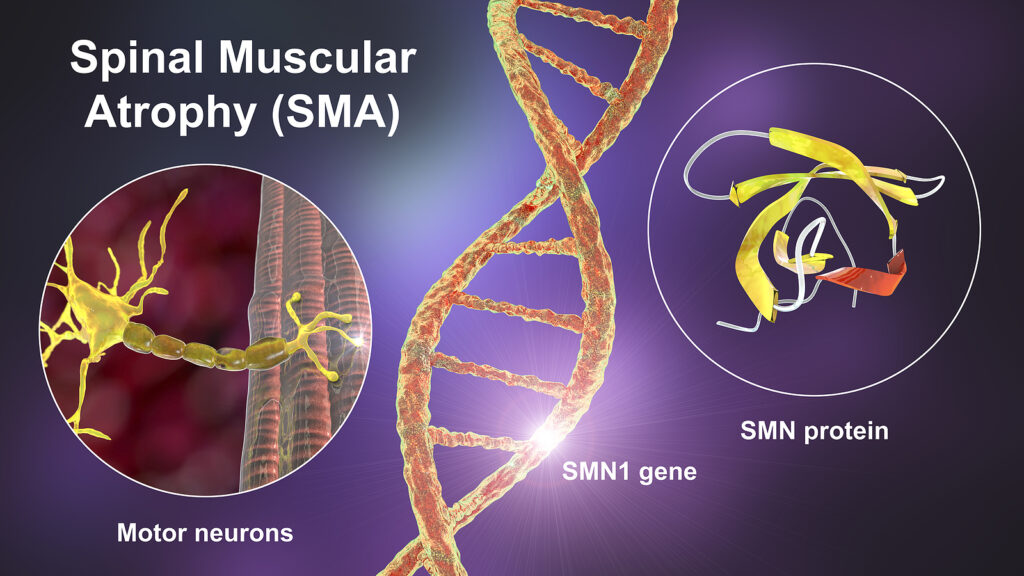By Lucy Piper, medwireNews Reporter
medwireNews: Apitegromab improves motor function in patients with later-onset spinal muscular atrophy (SMA), show the results of the phase 2 TOPAZ study.
Apitegromab “appears to provide substantial functional gains in participants with types 2 and 3 SMA,”say Thomas Crawford (Johns Hopkins University, Baltimore, Maryland, USA) and colleagues.
“The magnitude of effect appears to be greater in younger participants, though potential modest effects in older individuals may not have been discerned in this small pilot trial.”
The researchers studied the potential benefits of apitegromab, a fully human monoclonal antibody that selectively inhibits the activation of latent myostatin and, in turn, preserves muscle mass, in 54 individuals with SMA aged a mean of 9.4 years.
They received the drug intravenously every 28 days for 12 months according to one of the three following treatment regimens.
Cohort 1 comprised 23 ambulatory individuals aged 2–21 years old with type 3 SMA who received open-label apitegromab 20 mg/kg alone (n=11) or in combination with the antisense oligonucleotide agent nusinersen (n=12). Cohort 2 consisted of 14 nonambulatory participants aged 5–21 years who had type 2 or 3 SMA and received open-label apitegromab 20 mg/kg plus nusinersen. And cohort 3 included 17 nonambulatory patients aged at least 2 years with type 2 SMA who were randomly assigned to receive apitegromab at either a low dose of 2 mg/kg (n=9) or a high dose of 20 mg/kg (n=8) in addition to nusinersen.
Before enrolment in the study, the participants receiving nusinersen had received a mean of nine doses over a mean duration of 25.9 months and were anticipated to remain on therapy throughout the study. They received their maintenance nusinersen dose at least 24 hours after or at least 14 days before being given apitegromab.
Outcomes were assessed using the Revised Hammersmith Scale (RHS) for ambulatory patients and the Hammersmith Functional Motor Scale Expanded (HFMSE) for nonambulatory patients.
At day 364, patients in cohort 1 receiving apitegromab alone had a significant mean 0.4-point reduction in total score on the RHS, from a mean of 47.6 points (out of a possible 69.0 points) at baseline. And those receiving apitegromab plus nusinersen had a significant mean reduction of 0.3 points, from a mean 51.3 points at baseline.
The researchers note that 27.3% and 16.7% of patients receiving apitegromab alone or with nusinersen, respectively, achieved at least a 3-point increase in RHS scores, equating to a measurable improvement in two or three motor item skills, while an increase of at least 5 points was achieved by a corresponding 9.1% and 0.0%.
Patients in cohort 2 had a mean increase in HFMSE scores of 0.6 points, from a mean baseline score of 22.7 points out of a possible 66 points. Increases of at least 3 and 5 points were achieved by 28.6% and 14.3% of patients, respectively.
Among patients in cohort 3, the mean increases in HFMSE scores were 5.3 points and 7.1 points for those taking the low and high dose of apitegromab, respectively, from mean baseline scores of 26.1 and 23.5 points. Scores improved by at least 3 points in a corresponding 55.6% and 62.5% of patients, and the same proportion of patients in each group achieved at least a 5-point increase in score.
The improvements in HFMSE scores were evident from 8 weeks, Crawford and co-authors highlight in Neurology.
They also report the findings of a post-hoc analysis in which they divided cohort 3 participants into two groups according to age: 5–12 years and 13–21 years. The younger individuals had a mean 4.7-point increase in HFMSE score between baseline and 1 year, compared with a mean 0.7-point decrease among those in the older age group. The prepubertal age group were also more likely to achieve at least a 3-point improvement in HFMSE score, at 56% versus 0%.
“Apitegromab displayed an acceptable safety profile after 12 months of therapy,” says the team. The five most frequent treatment-emergent adverse events of grade 1 or 2 across all participants were headache (24.1%), pyrexia (22.4%), upper respiratory tract infection (22.4%), cough (22.4%), and nasopharyngitis (20.7%).
“The results of this pilot trial suggest the potential for apitegromab to result in clinically meaningful benefits and value in further randomized studies,” say the researchers.
They add that a phase 3 randomized, placebo-controlled trial – SAPPHIRE – is currently underway.
News stories are provided by medwireNews, which is an independent medical news service provided by Springer Healthcare Ltd. © 2024 Springer Healthcare Ltd, part of the Springer Nature Group
Neurology 2024; 102: e209151

